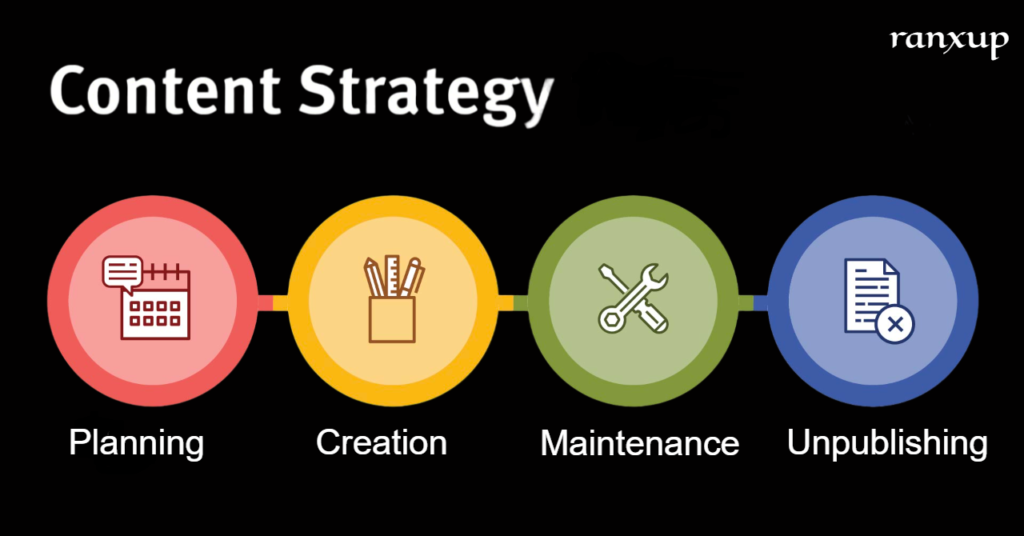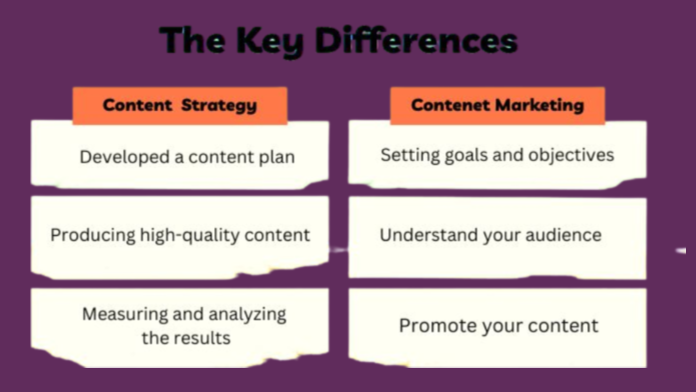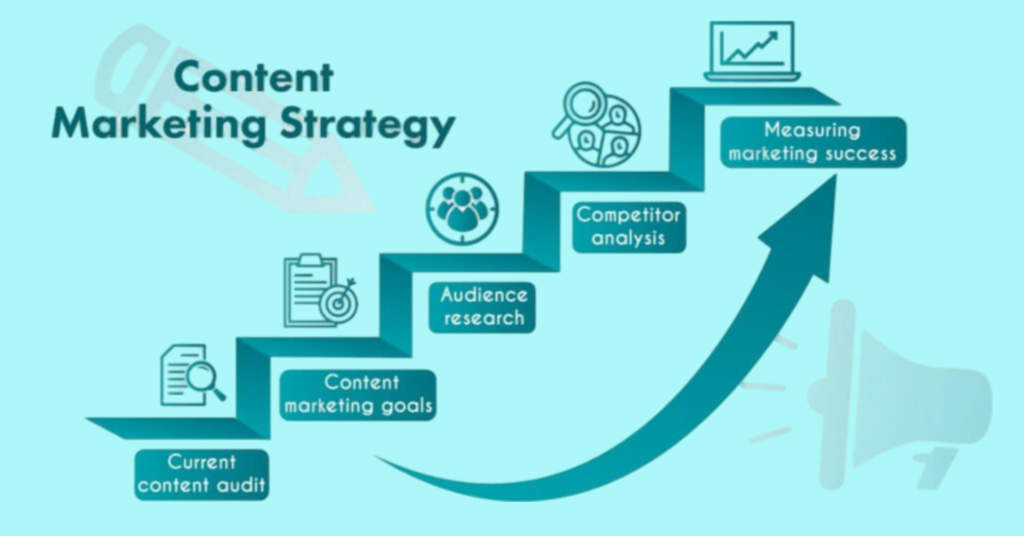In the ever-evolving world of digital marketing, the terms “content marketing” and “content strategy” are often used interchangeably, leading to confusion about their meanings and roles in a brand’s marketing efforts. While they are closely related, content marketing and content strategy represent distinct approaches that contribute to a brand’s overall marketing success.
Content marketing revolves around the creation and distribution of valuable and relevant content to attract, engage, and retain a specific target audience. It focuses on crafting compelling blog posts, and social media updates, videos, and other content assets to build brand awareness, drive customer engagement, and ultimately generate profitable customer actions. Content marketing is about using content as a strategic tool to connect with potential customers, provide them with value, and create a lasting impression.
On the other side, content strategy involves the planning, development, publication, management, and governance of content. It is a systematic approach that provides a strategic framework for content creation and distribution. The content strategy encompasses defining clear goals and objectives for content, conducting thorough audience research and segmentation, developing a content plan and calendar, establishing the right content distribution channels, and implementing effective content measurement and analysis. It ensures that content creation and distribution align with the brand’s marketing goals and objectives.
Although content marketing and content strategy are intertwined, they have distinct focuses and objectives. Understanding the differences between content marketing and content strategy is essential for businesses to optimize their marketing efforts.
In this blog post, we will delve deeper into the definitions, purposes, and key differences between content marketing and content strategy. We will explore the benefits and challenges of each approach and discuss how businesses can leverage both to effectively achieve their marketing goals.
Understanding Content Marketing

Content marketing has become an indispensable tool for businesses looking to connect with their target audience and drive meaningful engagement. But what exactly is content marketing, and why is it so important?
- At its core, content marketing is the strategic approach of creating and distributing valuable, relevant, and consistent content to attract and retain a clearly defined audience. Unlike traditional advertising, which focuses on promoting products or services, content marketing aims to provide value to consumers through informative, entertaining, or educational content. By delivering content that resonates with their audience’s needs and interests, businesses can build trust, establish authority, and foster long-term relationships.
- To truly grasp the concept of content marketing, it’s crucial to understand its key principles. First and foremost, content marketing is about putting the audience’s needs first. By understanding their pain points, desires, and preferences, businesses can create content that addresses their specific challenges and interests. This customer-centric approach allows companies to develop a deep connection with their audience.
- Another vital aspect of content marketing is consistency. Successful content marketing requires a regular cadence of content creation and distribution. Whether it’s blog posts, social media updates, videos, or podcasts, consistency ensures that businesses remain top of mind for their audience and maintain a consistent brand presence across different platforms.
- Moreover, content marketing is not just about creating content for the sake of it. It requires a strategic approach. Businesses must set clear goals and objectives for their content marketing efforts. Whether it’s increasing brand awareness, driving website traffic, or generating leads, having defined goals helps guide the content creation process and measure success.
- Content marketing also means leveraging the right channels for content distribution. This involves selecting the platforms where the target audience spends their time and tailoring the content to suit each platform’s format and requirements. By reaching the audience where they are most receptive, businesses can maximize the impact of their content marketing efforts.
- Content marketing is crucial for businesses seeking to establish a strong online presence, connect with their audience, and drive meaningful engagement. By consistently creating valuable content that addresses audience needs, setting clear goals, and leveraging the right distribution channels, businesses can unlock the power of content marketing and achieve their marketing objectives. So, dive deep into the world of content marketing and unlock its potential to elevate your brand’s online presence and drive business success.
Exploring Content Strategy

Content strategy is a crucial element in the success of any content marketing initiative. It involves the careful planning, creation, distribution, and management of content to achieve specific business goals. By exploring content strategy, businesses can align their content efforts with their overall marketing objectives and effectively reach their target audience.
- A well-executed content strategy starts with defining clear goals and objectives. This involves understanding the purpose of the content, whether it’s to increase brand awareness, drive website traffic, or generate leads. With a clear direction in mind, businesses can then conduct thorough audience research and segmentation to identify the specific needs and preferences of their target audience.
- Once the target audience is defined, content strategists can develop a comprehensive content plan and calendar. This includes deciding on the types of content to create, determining the frequency of publication, and mapping out how the content will be distributed across various channels. By strategically planning the content creation and distribution process, businesses can ensure that their content reaches the right audience at the right time.
- In addition to content planning, content strategy also involves establishing the right content distribution channels. This could include leveraging social media platforms, email marketing, search engine optimization, or even partnering with influencers and industry publications. By selecting the most effective distribution channels, businesses can maximize the reach and impact of their content.
- Lastly, content measurement and analysis play a crucial role in content strategy. By tracking key performance indicators such as website traffic, engagement metrics, and conversion rates, businesses can understand the effectiveness of their content efforts. This data-driven approach allows them to make informed decisions and continually optimize their content strategy for better results.
Key Differences Between Content Marketing and Content Strategy

While content marketing and content strategy are closely related, they are distinct concepts that play different roles in the overall marketing landscape. Understanding the key differences between the two is essential for businesses to effectively leverage both strategies and achieve their marketing objectives.
- Content marketing focuses on the creation and distribution of valuable, relevant, and consistent content to attract and engage a target audience. It is the tactical implementation of content to drive brand awareness, customer engagement, and conversions. Content marketing involves producing various types of content, such as blog posts, social media updates, videos, and podcasts, to provide value to consumers and build long-lasting relationships.
- On the other hand, content strategy is the strategic planning and management of content to align with overall business goals. It involves defining the purpose and goals of the content, conducting audience research and segmentation, developing a comprehensive content plan, selecting the appropriate distribution channels, and analyzing performance metrics. Content strategy provides the framework and direction for content marketing efforts, ensuring that the content created is aligned with the business’s objectives and effectively reaches the target audience.
- In essence, content marketing is the execution of content, while content strategy is the blueprint that guides and informs the content marketing activities. Content marketing focuses on the “how” of content creation and distribution, while content strategy focuses on the “why” and “what” behind the content. Content marketing without a solid content strategy can result in disjointed and ineffective content efforts. In contrast, a well-defined content strategy without effective content marketing may not reach the intended audience or achieve desired outcomes.
To sum it up, content marketing and content strategy work hand in hand to drive successful content initiatives. Content marketing is the tactical implementation, while content strategy provides the strategic framework and direction.
Benefits and Challenges of Content Marketing and Content Strategy

Content marketing and content strategy are powerful tools that businesses can enhance to connect with their audience, drive engagement, and achieve their marketing goals. However, like any marketing approach, they come with their own set of benefits and challenges that businesses need to be aware of. Let’s explore the benefits and challenges of content marketing and content strategy.
Benefits of Content Marketing
- One of the key benefits of content marketing is its ability to build brand awareness and establish credibility. By consistently creating and distributing valuable content, businesses can position themselves as industry thought leaders and gain the trust of their audience.
- Content marketing also allows businesses to showcase their expertise, educate their audience, and provide solutions to their pain points, which can lead to increased brand loyalty and customer retention.
- Another benefit of content marketing is the ability to drive organic traffic to a business’s website. By creating high-quality, search-engine-optimized content, businesses can improve their rankings in search engine results pages, attracting more visitors to their sites. This increased traffic can then be converted into leads and sales, contributing to business growth and revenue generation.
Benefits of Content Strategy
- Content strategy provides a structured approach to content creation and distribution. One of the major benefits of content strategy is its ability to align content initiatives with overall business goals.
- A well-defined content strategy helps businesses identify their target audience, understand their needs and preferences, and create content that reverberates with them. This targeted approach leads to higher engagement, improved customer satisfaction, and better overall marketing performance.
- Content strategy also helps businesses optimize their content efforts by identifying the most effective channels for content distribution. By understanding where their target audience spends their time online, businesses can focus their resources on those channels and maximize the reach and impact of their content. This targeted distribution approach leads to more meaningful interactions, increased brand visibility, and higher conversion rates.
However, both content marketing and content strategy come with their fair share of challenges. One of the main challenges is the need for consistent and high-quality content creation. Producing valuable content regularly can be time-consuming and resource-intensive. It requires a dedicated team, effective planning, and a commitment to maintaining a consistent publishing schedule.
Conclusion
In conclusion, content marketing and content strategy are two integral components of a successful marketing strategy, each with its distinct role and purpose. Content marketing focuses on the creation and distribution of valuable content to engage and attract an audience, while content strategy provides the strategic framework for planning, managing, and optimizing content.
To succeed in today’s competitive landscape, businesses must integrate content marketing and content strategy into their overall marketing efforts. This involves setting clear objectives, conducting audience research, developing a comprehensive content plan, selecting the right distribution channels, and continuously analyzing and optimizing content performance.
FAQs: Content Marketing vs Content Strategy
1. What is the major difference between content marketing and content strategy?
Content marketing focuses on the creation and distribution of valuable content to engage and attract an audience, while content strategy provides the strategic framework and direction for creating and managing content to align with overall business goals.
2. How do content marketing and content strategy work together?
Content marketing and content strategy work together to ensure that the content created is purposeful, targeted, and aligned with business objectives. Content strategy provides the roadmap and direction for content marketing efforts, guiding the creation, distribution, and optimization of content.
3. What are the benefits of content marketing?
Content marketing offers several benefits, including building brand awareness, establishing credibility, driving organic traffic, nurturing customer relationships, and showcasing expertise in the industry. It can also generate leads and sales by providing valuable solutions to customer challenges.
4. What are the benefits of content strategy?
Content strategy helps businesses align their content initiatives with overall business goals, target the right audience, optimize content distribution channels, and ensure consistent and high-quality content creation. It provides a strategic framework for effective content planning, management, and governance.
5. What are the challenges in implementing content marketing and content strategy?
Challenges in implementing content marketing and content strategy include the need for consistent and high-quality content creation, staying up-to-date with the rapidly changing digital landscape, and allocating resources for content production. It also requires ongoing learning, experimentation, and adapting to new technologies and trends.
6. How can businesses measure the effectuality of their content marketing efforts?
Businesses can measure the effectiveness of their content marketing efforts by tracking key performance indicators (KPIs) such as website traffic, engagement metrics (likes, shares, comments), conversion rates, lead generation, and customer retention. Content scoring metrics and analytics tools can provide insights into content performance and audience engagement.
7. How can businesses align their content marketing strategy with their business goals?
To align their content marketing strategy with business goals, businesses should define clear objectives, conduct audience research, develop a comprehensive content plan, select the right distribution channels, and continuously analyze and optimize content performance. Regularly reviewing and adjusting the strategy based on performance metrics is also crucial.
8. What role does audience research play in content strategy?
Audience research is vital in content strategy as it helps businesses understand their target audience’s needs, preferences, and pain points. It enables businesses to create content that resonates with the audience, addresses their challenges, and provides value. Audience research also helps in targeting content to different stages of the buyer’s journey and selecting the most effective communication channels.
9. How can businesses ensure consistent and high-quality content creation?
Businesses can ensure consistent and high-quality content creation by developing a content strategy that outlines the brand’s voice, target audience, and content types. Establishing editorial guidelines, conducting thorough research, and maintaining a content calendar can help in planning and organizing content creation. Collaboration with subject matter experts and regular quality checks can ensure the content meets the desired standards.
10. How can businesses optimize their content distribution channels for maximum reach and impact?
To optimize content distribution channels, businesses must identify the channels where their target audience is most active and engaged. They can leverage social media platforms, email marketing, search engine optimization (SEO), influencer partnerships, and paid advertising to reach their audience effectively. Regular monitoring and analysis of channel performance can help businesses refine their distribution strategy for maximum reach and impact.

